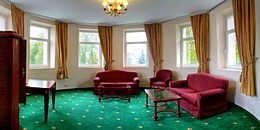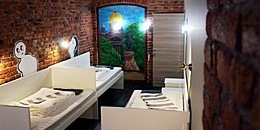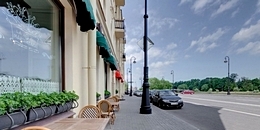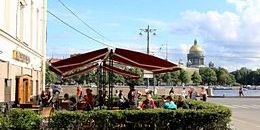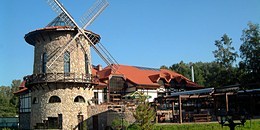Neva River
The Neva is the main waterway of Petersburg and the town is situated along its banks and across the islands of its broad delta. It is one of the largest rivers in Europe by volume of water and also one of the world's shortest major rivers at only 74 kilometers. The Neva connects Lake Ladoga, the largest lake in Europe, to the Baltic Sea. For centuries, it was of great strategic importance for transport and so the interests of the Russians, Swedes, Finns, and Balts clashed on its banks. From the 8th-13th centuries, the Neva was part of the trade route from Scandinavia to Byzantium, the road "from the Varangians to the Greeks." In 1240, the Novgorod militia led by Prince Alexander Yaroslavich defeated the invading Swedish army on the banks of the Neva. Because of the victory, the prince was thereafter nicknamed Alexander Nevsky (of the Neva). But the main page in the history of this great river began to be written, of course, in 1703 when St. Petersburg was founded at the mouth of the Neva.
The first architects tasked with building the city correctly assessed the value of urban development along the Neva. The river became the main architectural axis of the new Russian capital. It began with the large-scale construction of embankments, when its banks were straightened and covered with earth. For three centuries the embankments edged further and further into the river, near the Summer Garden, for example, by 50 meters, at the Winter Palace by 90 meters, on the Spit of Vasilievsky Island about 120 meters, and on Pirogovskaya Embankment about 150-200 meters. The first embankments were made of wood, but from the 1760s they began to be replaced with granite cladding. Thus the famous granite embankments of the Neva were born, and quickly became an intrinsic feature of St. Petersburg's cityscape.

Petersburgers immediately began building not only on the banks of the Neva River, but also on the islands in the delta - Vasilievsky and Petersburgsky (now the Petrograd Side). Despite Peter the Great's initial desire that the residents of his new city use boats to navigate St. Petersburg's waterways, it soon became apparent there was an urgent need for bridges. The first temporary floating bridge to Vasilievsky Island appeared in 1727, but it wasn't until 1850 that the first permanent bridge - Blagoveschensky (Annunciation) - was opened. Now more than 20 bridges span the river and its armlets. Most of these bridges are bascule bridges and are opened at night during the navigational season for large vessels to pass through. Among the most beautiful are the Troitsky (Trinity), Dvortsovy (Palace), and Bolshoy Okhtinskiy Bridges. Watching the raising of the bridges, whether from the embankments or from a pleasure boats, is one of the great St. Petersburg experiences during the White Nights of June and July.

From the first years of its existence, St. Petersburg was vulnerable to the one certain danger of its main river: floods. In the autumn, strong winds drive water from the Gulf of Finland, and there were cases when flooding exceeded three or four meters above normal water levels. The worst flood in the history of St. Petersburg (described by Alexander Pushkin in his long narrative poem "The Bronze Horseman") took place in November 1824, when the water reached 421 centimeters above sea level. In 1978, construction began on a dam in the Gulf of Finland designed to protect against flooding. The dam is still not fully completed, but the risk is much less now and water only occasionally pours out over onto some embankments.

At the beginning of the 20th century, electric trams rode over the frozen Neva and the river was traditionally used for skating. Today, in some particularly warm winters the Neva does not completely freeze. In such weather, ships and pleasure boats are still able to sail on the river and its channels even in December. In summer, about five hundred boats are used for transporting tourists alone. Besides the usual excursions, it is possible to buy tickets for dinner cruises, a ride on a jazz boat, or take a night tour.

Almost all of the major attractions of St. Petersburg are either placed directly beside the water or can be easily seen from a boat. Among them are the Peter and Paul Fortress, the Spit of Vasilievsky Island, the Cruiser Aurora, the Winter Palace, the Bronze Horseman, the Summer Garden, the Alexander Nevsky Monastery, Smolny Cathedral, the Marble Palace, the Admiralty, the Academy of Arts, the Kunstkamera, the grim Kresty Prsion, and many more. But the main attraction is, of course, the Neva itself, creating the unique atmosphere in the Venice of the North - a town between sky and water.

| Metro stations: | Admiralteyskaya, Sportivnaya, Ploshchad Lenina, Krestovsky Ostrov |
|---|---|
| Characteristics of the river: | Length in the city: 30 km Width: up to 1200 m Maximum depth: 24 m |
| Site dedicated to the Neva: | http://www.nevariver.ru/ |
| Timetable of bridge openings: | here |
| The most important islands: | Vasilievsky Island, Petrogradsky Island, Krestovsky Island, Decembrists Island, Zaichy island, Yelagin Island, Kamenny Island, Aptekarsky island |
| Notable embankments: | Voskresenskaya Naberezhnaya (Resurrection Embankment), Naberezhnaya Kutuzova (Kutuzov Embankment), Dvortsovaya Naberezhnaya (Palace Embankment), Admiralteiskaya Naberezhnaya (Admiralty Embankment), Angliskaya Naberezhnaya (English Embankment), Naberezhnaya Lomonosova (Lomonosov Embankment), Naberezhnaya Makarova (Makarova Embankment), Petrovskaya Naberezhnaya (Peters Quay) |
| Major bridges: | Bolshoy Obukhovsky Bridge, Alexander Nevsky Bridge, Bolsheokhtinsky Bridge, Liteiny Bridge, Troitsky (Trinity) Bridge, Dvortsovy (Palace) Bridge, Blagoveschensky (Annunciation) Bridge |





